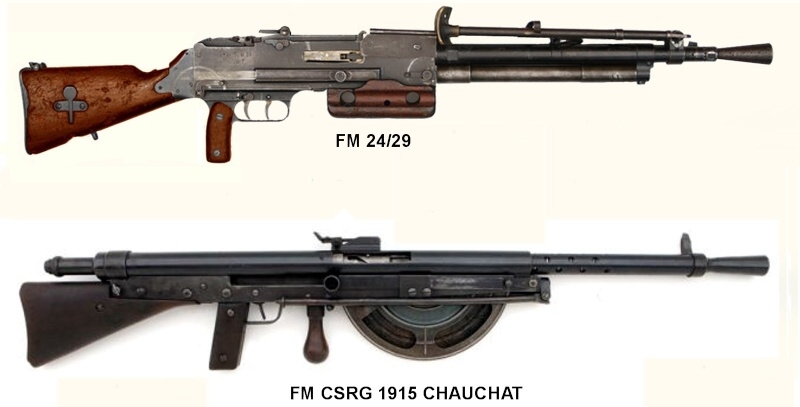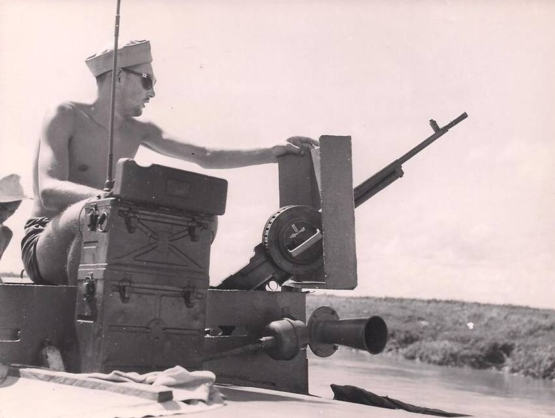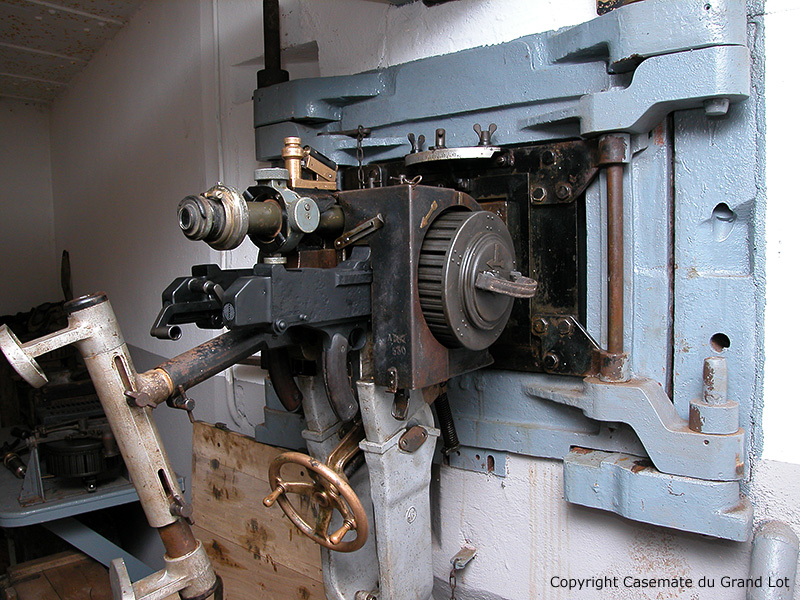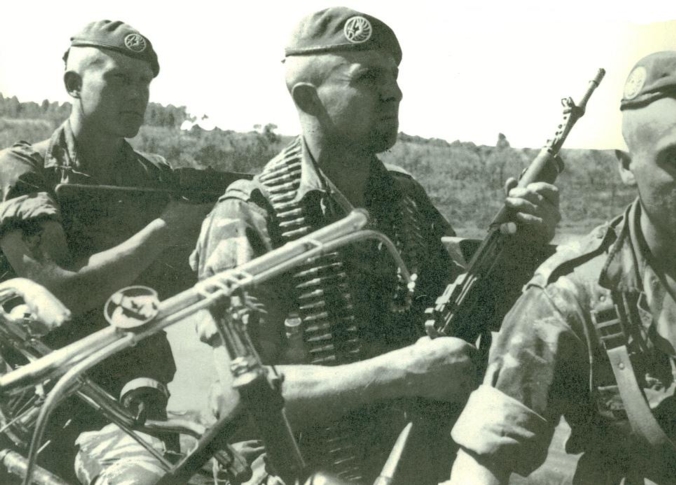At the end of WW1 the French faced the decision to replace the ageing 8mm Lebel and Berthier rifles with a more modern cartridge. Various experimental rounds were tested during that time period but in 1924 the 7.5 x 58 M24 was developed. However, not long afterwards in 1929 it was replaced by the shorter 7.5 x 54 MAS (Manufacture d’armes de Saint-Étienne) M29. The rifle adopted was the Modèle 36
Although the M36 did not see too much action during WW2, the French continued to produce it until the early 1950’s where it saw some service in the then French Indochina. It was a lightweight and rugged rifle that was suited to the jungle conditions of South East Asia. It was a bolt action rifle however so it became obsolete because most Western powers as well as the Communist Bloc already had semi-auto rifles that were developed just post WW2.

The M36 was upgraded to the M49/56 rifle that was a 10 shot semi auto rifle. More than a quarter of a million were manufacture until production ceased in the late 1970’s when the French had to follow their NATO counterparts and adopted the 5.56×45 NATO rifle.

BALL
FRENCH LOADINGS
 LM = Atelier fabrication du Mans
LM = Atelier fabrication du Mans


MI = Robert Paulet & Cie Société Méridionale d’Industrie (formerly Cartoucherie Léon Paulet) à Marseille.
F = Tréfileries et Laminoirs de la Méditerranée à St-Louis.

 GM NATO F1 BULLET
GM NATO F1 BULLET
SF: Société Française des Munitions (Gévelot) à Paris (In many cases SF supplied their own cases as well)
 I = Société de Métallurgie Franco-Belge à Issy Les Moulineaux.
I = Société de Métallurgie Franco-Belge à Issy Les Moulineaux.
 S: Compagnie Française des Métaux à Sérifontaine.
S: Compagnie Française des Métaux à Sérifontaine.




LM = Atelier de Fabrication du Mans, since 1936 resulting from the nationalization of a plant originally by Manurhin in 1927. Activities at the plant resumed in 1948 after WW2 until 1968 when it was amalgamated with Rennes Construction Workshop (for the large caliber ammunition), which later became GIAT Industries.
NM = Diehl Metall GmbH, Nuremberg


MR = Manufacture de machines du Haut-Rhin à Mulhouse-Boutzwiller.
DO = Unknown


R = Tréfileries and Laminoirs du Havre in Rugles. Sometimes loader as well as metal provider under the name of Cartoucherie de la Seine.




CC = unknown


VS = Atelier de Construction de Versailles.

 Laquered steel tip
Laquered steel tip
HEAVY BALL


CN is associated with two different factories, namely Atelier Mécanique de Normandie as well as Ets Claudinon et Cie, Le Chambon-Feugerolles.
PC = Ets Caillaux à Boulogne-s/Seine.


MR = Manufacture de machines du Haut-Rhin à Mulhouse-Boutzwiller.
C = Compagnie Française des Métaux à Castelsarrasin.


VS = Atelier de Construction de Versailles.
J = Code attributed to Compagnie Française du Bimétal, à Joinville-le-Pont.


S = Compagnie Française des Métaux à Sérifontaine.
 Laquered Steel Bullet (TE S 4-65 7,5)
Laquered Steel Bullet (TE S 4-65 7,5) 





LM = Atelier de Fabrication du Mans, from 1936 onward as a result of the nationalization of a plant originally by Manurhin in 1927. Activities at the plant resumed in 1948 after WW2 until 1968 when it was amalgamated with Rennes Construction Workshop (for large caliber ammunition), which later became GIAT Industries.
WB = Wurag Eisen und Stahlwerk a Hohenlimburg


SF = Société Française des Munitions, Paris et Issy-Les-Moulineaux.
HX = Hauts Fourneaux, Forges et Aciéries de Pompey (Meurthe et Moselle).

 Laquered steel bullet
Laquered steel bullet
TE = Ateliers de Construction de Toulouse
PO = Forges de la Providence à Redon.

 unvarnished case, most were scrapped
unvarnished case, most were scrapped

 Steel case
Steel case

 Experimental zinc-chronak case
Experimental zinc-chronak case

 Experimental aluminium case
Experimental aluminium case
OTHER COUNTRIES AND CONTRACT LOADS

 BELGIUM
BELGIUM

 Societe Industrielle Voltaique d’Armes et Munitions (SIVAM), Ouagadougou, Burkina Faso.
Societe Industrielle Voltaique d’Armes et Munitions (SIVAM), Ouagadougou, Burkina Faso.
 Manufacture Camerounnaise de Munitions, (State Factory). French Contract load for the Government of Cameroon
Manufacture Camerounnaise de Munitions, (State Factory). French Contract load for the Government of Cameroon

 LEBANON
LEBANON

 PORTUGAL
PORTUGAL




 SYRIA
SYRIA

 Vietnam
Vietnam

 Vietnam
Vietnam

 Quan Doi Viet Nam Cong Hoa Quan Cu., South Vietnam. (Establishment of Material of the Army of South Vietnam).
Quan Doi Viet Nam Cong Hoa Quan Cu., South Vietnam. (Establishment of Material of the Army of South Vietnam).

 Yugoslavia
Yugoslavia



 Yugoslavia
Yugoslavia
OTHER TYPES
ANTI LUEUR (low flash)


Headstamp is also in reverse, with year of manufacture at the bottom and trimester of manufacture at the top.
F = Tréfileries et Laminoirs de la Méditerranée à St-Louis.
MI = Robert Paulet & Cie Société Méridionale d’Industrie (formerly Cartoucherie Léon Paulet) à Marseille.
ARMOUR PIERCING

 Steel turned, tin plated tip
Steel turned, tin plated tip
TE = Atelier de Construction de Toulouse.
F = Tréfileries et Laminoirs de la Méditerranée à St-Louis.


N = Etablissement Navarre à Evreux.


S = Compagnie Française des Métaux à Sérifontaine.


D = Société Electromécanique de Dives , formerly Compagnie du Duralin de Dives


VE = Atelier de Construction de Valence, factory ceased production in 1962.
P = S.A. Des Mines et Fonderies de Pontgibaud prior to WW2. P was also the code for Société Française des Métaux à Couéran. (post WW2).



 Scale 200%
Scale 200%
ARMOUR PIERCING TRACER




AP-T Mle. 35A (A denotes a crimping groove on the bullet). Green p/a and neck seal with CN Steel core.
COPPER CRUSHER


VE = Atelier de Construction de Valence, factory ceased production in 1962.
F = Tréfileries et Laminoirs de la Méditerranée à St-Louis.
DUPLEX


INCENDIARY


SF = Société Française des Munitions (Gévelot) à Paris (In many cases SF supplied their own cases as well)
I = Société de Métallurgie Franco-Belge à Issy Les Moulineaux.


BA = Fonderies et Laminoirs de Paris, usines à Ruelle et Harfleur


D = Société Electromécanique de Dives , formerly Compagnie du Duralin de Dives
Incendiary Mle. 35 with blue p/a and neck seal with remnant of a blue tip.


MATCH


LM = Atelier de Construction du Mans.
SI = Societa Metallurgica Italiana (Florence)


 Case has a purple extractor groove
Case has a purple extractor groove
LM = Atelier de Construction du Mans.
NM = Diehl Metall GmbH, Nuremberg


LM = Atelier de Construction du Mans.
VA = Verenigte Deutsche Metallwerke, Altena


Match/High Accuracy sniper? load. KS bullet
VD = Societe Metallurgique de la Villedieu


KS bullet shown at 200%
PRESSURE TEST


PROOF



TRACER


SF = Société Française des Munitions (Gévelot) à Paris (In many cases SF supplied their own cases as well)
I = Société de Métallurgie Franco-Belge à Issy Les Moulineaux.
















TE = Ateliers de Construction de Toulouse
B = might be any one of the following:
Établissement Baroquet et Fouquet
Compagnie General d’Electrometallurgie
Compagnie du Duraluminium et du Cuivre, Boisthorel




GM Steel core
VE = Atelier de Construction de Valence, factory ceased production in 1962.
N = Etablissement Navarre à Evreux.

























 FN (Belgium)
FN (Belgium)


LM = Atelier de Fabrication du Mans
F = Tréfileries et Laminoirs de la Méditerranée à St Louis, formerly Société Huart et Cie, à Marseille.


VD = Code attributed to Société Metallurgique de La Villedieu










LM = Atelier de Fabrication du Mans, since 1936 resulting from the nationalization of a plant originally by Manurhin in 1927. Activities at the plant resumed in 1948 after WW2 until 1968 when it was amalgamated with Rennes Construction Workshop (for the large caliber ammunition), which later became GIAT Industries.
WR = Stahlwerke Sudwestfalen GmbH


Short range tracer Mle. F3 for L.R.A.C. 89 mm and Apilas rocket.






Below are two variations of the short range spotter tracer Mle. F2 for the 106mm recoilless rocket.


LM = Atelier de Fabrication du Mans, since 1936 resulting from the nationalization of a plant originally by Manurhin in 1927. Activities at the plant resumed in 1948 after WW2 until 1968 when it was amalgamated with Rennes Construction Workshop (for the large caliber ammunition), which later became GIAT Industries.
EW = Attributed to Eschweiler Bergwerks Verein à Eschweiller, RFA.


VA = Verenigte Deutsche Metallwerke Altena
BLANK

 ASSMAN (Austria)
ASSMAN (Austria)


LM = Atelier de Fabrication du Mans, since 1936 resulting from the nationalization of a plant originally by Manurhin in 1927. Activities at the plant resumed in 1948 after WW2 until 1968 when it was amalgamated with Rennes Construction Workshop (for the large caliber ammunition), which later became GIAT Industries.
DA = Sigle d’Usinor S.A., usine de Denain-Anzin.






Blank Mle. 58M. Virtually the same as the Mle. 58 but with primer ring crimp.






Blank Mle. F1 with white/translucent body with aluminium or galvanised / chromated steel base Blank Mle. 58 with white/translucent body with galvanised or chromated steel base




Mle. 69 Blank. Aluminium or chromated steel base




Systeme Paulet
MI = Robert Paulet & Cie Société Méridionale d’Industrie (previously Cartoucherie Léon Paulet) à Marseille.



 Fired blank
Fired blank


MR = Manufacture de machines du Haut-Rhin à Mulhouse-Boutzwiller.
D = Electromechanical Company of Dives, later became Compagnie du Duralumin and Copper
This case was formed from old 7.5×58 Mle.24 cases as can be seen from the date (1928), so this is a very early blank.


Gold painted tip. This is a movie blank

 Steel case.
Steel case.


TE = Ateliers de Construction de Toulouse
CCM = Compagnie des Forges de Châtillon Commentry et Neuves-Maisons.


Machinegun Blank Mle. 30 with natural wooden bullet. Bullets were natural or blue coloured until March 1958, when it was changed to purple/lilac.
TH = Cartoucherie de la Seine a subsidiary of the Tréfileries du Havre group in Rugles.
R = Tréfileries and Laminoirs du Havre, Rugles. Sometimes also the case supplier under the name of Cartoucherie de la Seine.


Machinegun Blank Mle. 36.


Rifle Blank Mle. 1937.
TE = Ateliers de Construction de Toulouse
D = Electromechanical Company of Dives, which subsequently became Duralumin and Copper Company


P = Société Française des Métaux à Couéran, post 1945




Laquered steel case. The sequence on the headstamp is different from normal as the trimester of manufacture and metal supplier (C) were switched.




CCM = Compagnie des Forges de Châtillon Commentry et Neuves-Maisons




H = Tréfileries and Laminoirs du Havre, Graville plant


BD = Les Fils de Victor Bidault et Cie, à Vitry sur Seine. There are 2 other manufacturers that also utilised code BD, namely Etablissement Brandt, de Levallois (during the period between WW1 and WW2) and Societè de Forges Barriol & Fils/Ch. Daillierè à Andrezieux (1914-1918).








Very early blank manufactured from reworked 7.5×58 Mle. 24 cases
MR = Manufacture de machines du Haut-Rhin à Mulhouse-Boutzwiller
D = Electromechanical Company Dives, which subsequently became Duralumin and Copper Company


Machine gun blanks for the FM 24/29 and Reibel MAC 31. From March 1958 all blanks were purple/lilac coloured. This was also the period when wooden bulleted blanks were being phased out because in 1958 the plastic Mle. 58 blanks were already in use. It was also no longer colour coded (blue for the FM 24/29 and red for the MAC 31). There is now a differentiation between a more rounded profile for the FM 24/29 and pointed for the MAC31.




TE = Ateliers de Construction de Toulouse
TLM = Tréfileries et Laminoirs de la Méditerranée, usine de Marseille
The Fusil-Mitrailleur Modèle 1924 M29 was the standard light machine gun of the French Army from 1925 until the 1960s. After the end of World War I, the French Army sought to replace the problematic Fusil-mitrailleur mle 1915 CSRG light machine rifle (better known as the Chauchat). French commanders considered standardizing on the American Browning Automatic Rifle (BAR), but eventually required the development of a locally built weapon. MAS (an abbreviation of Manufacture d’Armes de St. Etienne – one of several government-owned arms factories in France) proposed a direct derivative of the BAR, but the Manufacture d’Armes de Châtellerault (MAC) won the bid with its weapon, which was partly derived from the BAR action. It had been formulated and designed by a Lieutenant Colonel Reibel assisted by Chief Armorer Chosse.
The FM Mle 1924 entered production in late July 1925 and saw first operational use in Morocco in May 1926. It was originally chambered for the 7.5×58 Mle. 24 cartridge, but that caused some serious problems for the French in that the 7.9×57 used by Germany also fitted in the M24 with disastrous results. This indirectly lead to the development of the 7.5 Mle. 29. (wikipedia)

The REIBEL MAC31 was developed from the Mle. 24/29 Machinegun in 1930. The main difference was that it made use of a 150 round drum fed magazine. It was also known as the JM Reibel, with JM meaning Jumelage de mitrailleuses which means twin machine gun mounting. Reibel is the name of the director of the state owned arms factory MAC (Manufacture d’armes de Chatellerault) where it was developed and produced. As can be seen from the picture below, it was used on the Maginot line with the twin barrel configuration for an accelerated rate of fire, or continuous use where one barrel can be left to cool while the second barrel was in operation.


DUMMY



 Magazine Stopper
Magazine Stopper

 Box test dummy
Box test dummy


Dummy load with hollow nickel jacket
SF: Société Française des Munitions (Gévelot) à Paris (In many cases SF supplied their own cases as well)
I = Société de Métallurgie Franco-Belge à Issy Les Moulineaux.


Laquered steel tip. Case is filled with coarse sand to simulate weight.
TE = Atelier de Construction de Toulouse.
TLM = Tréfileries et Laminoirs de la Mèditeranee à Marseille




VE = Atelier de Construction de Valence, company ceased production in 1962 D: Société Electromécanique de Dives, formerly Compagnie du Duralumin de Dives.
BA = Fonderie et Laminoirs de Paris. Usine à Ruelle et Harfleur.


VS = Atelier de Construction de Versailles.
S = Compagnie Française des métaux à Sérifontaine


Lesteè = Ballast. Loaded with a coarse inert filler to simulate the weight of a loaded round.
LM = Atelier de Fabrication du Mans, since 1936 resulting from the nationalization of a plant originally by Manurhin in 1927. Activities at the plant resumed in 1948 after WW2 until 1968 when it was amalgamated with Rennes Construction Workshop (for the large caliber ammunition), which later became GIAT Industries.
EW = Attributed to Eschweiler Bergwerks Verein à Eschweiller, RFA.
GRENADE BLANK


LM = Atelier de Construction du Mans.
BO = Atelier & Forges de la Loire usine de Boucau




SF = Société Française des Munitions (Gévelot) à Paris
I = Société de Métallurgie Franco-Belge à Issy Les Moulineaux.


S = Compagnie Française des Métaux à Sérifontaine.


TE = Atelier de Construction de Toulouse.
B = might be any one of the following:
Établissement Baroquet et Fouquet
Compagnie General d’Electrometallurgie
Compagnie du Duraluminium et du Cuivre, Boisthorel




Pressure Test case
C = Compagnie Française des Métaux à Castelsarrazin, (Metal Provider)


D = Société Electromécanique de Dives devenue Compagnie du Duralin de Dives






F = Tréfileries et Laminoirs de la Méditerranée à St-Louis.


I = Société de Métallurgie Franco-Belge à Issy Les Moulineaux.


Grenade/propulsive blank Mle. F1 with cork filler, rose crimp, neck crimp and bitumen seal.
N = Etablissement Navarre à Evreux.


VE = Atelier de Construction de Valence, company ceased production in 1962
BD = Les Fils de Victor Bidault et Cie, à Vitry sur Seine. There are 2 other manufacturers that also utilised code BD, namely Etablissement Brandt, de Levallois (during the period between WW1 and WW2) and Societè de Forges Barriol & Fils/Ch. Daillierè à Andrezieux (1914-1918).











VS = Atelier de Construction de Versailles.
BS = Atelier de Laminage de l’Ecole Centrale de Pyrotechnie de Bourges



 Electric Primed grenade blank – no headstamp
Electric Primed grenade blank – no headstamp




Neck has a seperate brass collar, with concave mouth
VE = Atelier de Construction de Valence, company ceased production in 1962
FY = Compagnie des Ateliers et Forges de la Loire, de Firminy












Propulsive Blanks for anti-riot use, tear gas grenades.

 Belgian Grenade Blank by FN
Belgian Grenade Blank by FN
SUB-CALIBER AND GALLERY LOADS




Sub-Cal load for 73mm Rocket (electric primed)





 Sub-cal. for 73mm Rocket (Aluminium case/Electric Primed)
Sub-cal. for 73mm Rocket (Aluminium case/Electric Primed)

 Experimental Aluminium cased sub-cal. for 89mm LRAC/Apilas F1 Rocket. Nickel plated lead ball.
Experimental Aluminium cased sub-cal. for 89mm LRAC/Apilas F1 Rocket. Nickel plated lead ball.

 Sub-Cal device for 22LR
Sub-Cal device for 22LR
SHORT RANGE






Short range for aircraft use, CN with aluminium core.
VS = Atelier de Construction de Versailles.
I = Société de Métallurgie Franco-Belge à Issy Les Moulineaux.

 Sub-Sonic with laquered steel bullet.
Sub-Sonic with laquered steel bullet.






























MI = Robert Paulet & Cie, Société Méridionale d’Industrie, formerly Cartoucherie Léon Paulet à Marseille. Ceased production end of 1965.
F = Tréfileries et Laminoirs de la Méditerranée à St Louis, formerly Société Huart et Cie, à Marseille.


RY = Etablissements Rey Frères à Nimes, which became a subsidiary of Nobel Bozel
C = Compagnie Française des Métaux à Castelsarrasin.


SF = Société Française des Munitions, Paris et Issy-Les-Moulineaux.
GP = unknown





 Short range Mle.61
Short range Mle.61



 Experimental loadings
Experimental loadings

 Short range Mle. F2 for 89mm LRAC rocket. The electric primer is Mle. 79 B 201
Short range Mle. F2 for 89mm LRAC rocket. The electric primer is Mle. 79 B 201

 Short range 1st type, Mle. F3
Short range 1st type, Mle. F3
WEIGHT TEST


MR = Manufacture de machines du Haut-Rhin à Mulhouse-Boutzwiller
C = Compagnie Française des Métaux à Castelsarrasin.


VE = Atelier de Construction de Valence. Company in production from 1882 to end of 1962.
PC = Ets Caillaux à Boulogne-s/Seine.


 French Commando with the M49/56 rifle
French Commando with the M49/56 rifle
